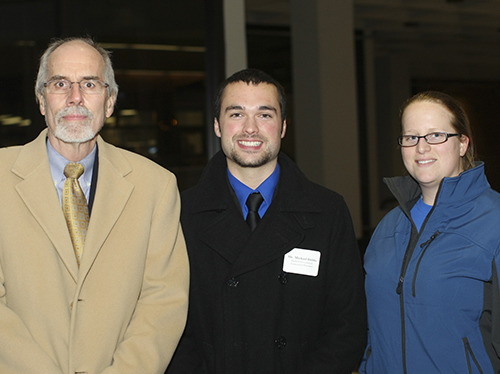
Students struggle to light candles as the wind blows outside the Curris Center, where the walk took place.
Doctors first called it a “Gay Plague” or “Gay Cancer.” Later on it was diagnosed as human immunodeficiency virus and is now known as one of the most destructive pandemics of recent years.
According to its website, World AIDS Day first occurred in 1988 on the first ever Global Health Day in order to spread awareness of HIV and its impact upon society.
It is an opportunity for people worldwide to come together against the virus, show their support for people living with HIV and memorialize people who have died.
The website stated 34 million people have been diagnosed with HIV worldwide. 35 million have died of AIDS, the final stage of HIV, making it one of the most destructive pandemics of the modern era.
The event on campus was orchestrated by Jody Cofer Randall, LGBT coordinator, Don Robertson, vice president of Student Affairs, and Michael Dobbs, president of the Student Government Association.
A group of 20 gathered on the steps of Lovett Auditorium and began with a candlelit walk to the Curris Center in silence at 7 p.m., paying tribute to those who have died from HIV/AIDS and to think about those who still struggle with the virus/disease today.
The tour ended with Dobbs giving a speech in honor of those still afflicted with HIV/AIDS in the second floor meeting area.
Matthew Allen, freshman from Tompkinsville, Ky., said as a member of the LGBT community, it was important to raise awareness about the issue that so many faced and to let people know that everyone is at risk.

/ By the numbers: The CDC’s 2011-2013 HIV/AIDS statistics shows those affected.
After the speech, “We Were Here,” a documentary about five people living in the San Francisco when HIV/AIDS swept through in the 1980s, showed participants the variety of ways in which the community was affected.
One of the main speakers of the documentary, Guy Clark, spoke of how he had seen the customers in his flower shop gradually fade from sight, either dying or being too sick to rise from their beds.
Some of them lost friends and lovers, others , like Ed Wolf, witnessed inevitable death as they tried to help those diagnosed.
“I remember having a Buddhist friend who related it to seeing souls trapped in a body, unable to move on into the afterlife, and hungry. Hungry for comfort and warmth and care because no matter what, they were empty,” said Wolf in the film.
The film showed how HIV ravaged San Francisco, leaving over 15,000 dead according to a statistic in “We Were Here.”
“I knew AIDS was still a problem, and I knew how bad it was, so my view didn’t really change,” Allen said. “I know watching some of the testimonies especially touched a soft spot with me.”
It made him thankful that the medical advances made in the past few years allow for better treatment and care for not only AIDS patients, but for patients of any life-threatening disease, he said.

Don Robertson, vice president of Student Affairs, Michael Dobbson, SGA president, and Morgan Randall , Alliance president, attended the HIV/AIDS walk.
“I believe that HIV is underrepresented in the media and especially in youth,” Cofer Randall said. “If you go around Murray and Calloway County, the general consensus is that it doesn’t happen here or that it’s more of a New York or California thing, when in reality, it’s prevalent everywhere.”
Allen said if the media were to present the pandemic of HIV in mass media more, then it would get the attention it needs to educate the public on the virus and striving for a cure.
Cofer Randall also said that the disease is hard to see in the community because no one talks about it.
He said this is because of a stigma that HIV doesn’t occur in small or rural counties but in recent years the rates of infection among minorities like blacks are climbing at an alarming rate.
“HIV and AIDS are not restricted to the gay community and it is not always transmitted through sex,” Cofer Randall said.”
HIV can be transmitted through contact with open wounds, transmission of bodily fluids and sharing needles, according to the CDC website.
Story by Teddy Martin, Staff writer